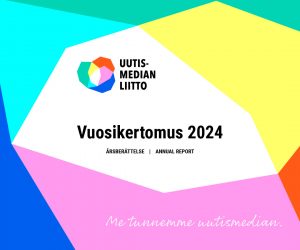Annual Report
116th Operating Year of News Media Finland
Trust in news remains high
 News Media Finland’s 116th year of operation was wrapped up in the midst of a tense international situation. Russia’s full-scale war of aggression against Ukraine continued for the third consecutive year. In the Middle East, Israel continued the destruction of Hamas and Gaza. Donald Trump was elected President of the United States.
News Media Finland’s 116th year of operation was wrapped up in the midst of a tense international situation. Russia’s full-scale war of aggression against Ukraine continued for the third consecutive year. In the Middle East, Israel continued the destruction of Hamas and Gaza. Donald Trump was elected President of the United States.
The phenomenon of news avoidance, which has become increasingly common around the world, also landed on our shores. The debate on the harmful effects of social media on people and societies intensified.
The digitalisation of news media accelerated, and the publication rates of printed publications were further reduced. Nevertheless, almost 70 per cent of news media revenue came from printed newspapers.
Subscription revenue accounted for 65 per cent of newspaper revenue. On average, the share of digital subscriptions alone already made up more than a third of total subscriptions.
International platform giants accounted for 68 per cent of the Finnish digital advertising market. The total amount of advertising decreased.
Safeguarding of interests: Media policies to support news media
As the government sharply tightened indirect taxation, magazines and newspapers were the only product where VAT could be kept at 10 per cent. Index increases in Yle’s funding were frozen for three years. The role and supervision of the public service remained unchanged, and the Finnish Media Federation brought related problems to the European Commission for the second time.
European press advocacy was strengthened with the new Commission. The importance of the vitality of news media is now better understood, as the challenges facing democracy and the security policy situation in Europe are guiding the Commission to find solutions.
The financial support of Ukrainian regional news media continued as Nordic cooperation. We received funding from the Ministry for Foreign Affairs for the Ukrainian media development cooperation project for 2025–2026.
Industry information, communications and marketing: Wide-reaching, reliable and educational news media
In Finland, trust in news remained high; the highest level observed in an extensive international survey. Almost everyone aged 15 and over read newspapers in some form. Finns considered newspapers to be by far the most reliable and educational form of media.
To support media sales, we investigated the role of newspapers in supporting voting decisions in the European Parliament elections.
We communicated actively about the importance and strengths of news media. We produced numerous marketing materials for the use of member media, the themes of which included the building blocks of the world image offered by news media, the central role of news media in the local community, constructive discussion, the power in freedom of expression and environmental responsibility.
Media education and information literacy: The ABC Book attracted international interest, and a TikTok survey sparked debate in the media
The media education activities of News Media Finland, which have now been running for six full decades, emphasised the importance of journalism and explaining the operating principles. The News Week was celebrated on the theme Löydä oma juttusi (“Find your own thing/story”), and the Nuoret ja uutismediasuhde (“Young people and their relationship to news media”) survey revealed that TikTok has become the most important news channel for young people aged 13–18.
We reached out to teachers at the Educa fair as well as via our oppituntivinkit (“lesson tips”) newsletter and social media channels. We offered teachers versatile tools for media education on our uutismedikasvatus.fi website.
Our information literacy project encouraged distinguishing between the value of editorial content and other internet and social media content. We published the Media ja demokratia (“Media and democracy”) learning material website designed for use by teachers of history and social sciences in upper secondary schools. We distributed The ABC Book of Media Literacy to all students in ninth grade.
Free newspapers and local newspapers: Work for the importance of reliable local information
The campaigns Kaupunkilehdet tutuiksi (“Get to know free newspapers”) and Pureudu paikallisiin (“Get stuck into locals”) reminded people of the diversity of news media.
The increase in delivery prices and the poor availability of delivery posed challenges to the publishing operations of city and local newspapers. A total of nine city and local newspapers reduced the number of publication days of their printed newspaper.
The prizes for the best city and local newspapers were awarded at the Vuoden parhaat (“Best of the Year”) gala at the Suuret Lehtipäivät event in Kokkola.
Suomen Lehdistö: First year online only
The year was the first for Suomen Lehdistö without a regular printed publication. A weekly newsletter, which reaches a growing group of nearly 4,500 media professionals, sets the pace for the new everyday life.
We covered topics such as interesting people in the industry, renewing editorial organisations, the media economy, journalism based on the needs of the public, artificial intelligence, new journalistic products on the market, digital activities, reducing the number of printed magazines and changes in the delivery of printed media. We also shared journalists’ expertise in popular Tekijä webinars.
Events and training: Sharing experiences on important topics
Our training activities increased even further. The majority of the events were held as webinars, and they reached more than 1,700 people during the year.
The Suuret Lehtipäivät event gathered in Kokkola over 200 participants from city and local newspapers from all over Finland.
Services for members: Supporting member companies
Our experts were available to our member companies in matters related to the development of the industry as well as various legal issues related to publishing operations. We also visited several of our member companies during the year.